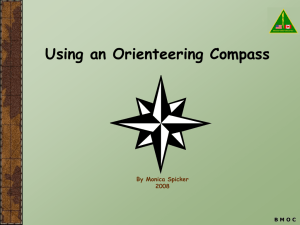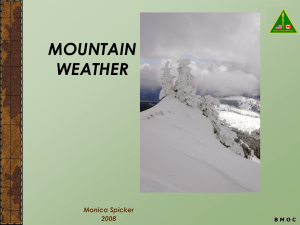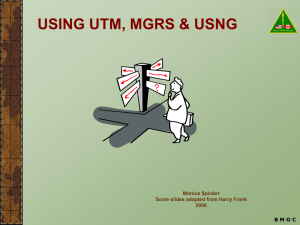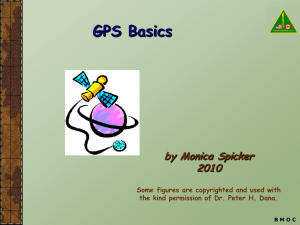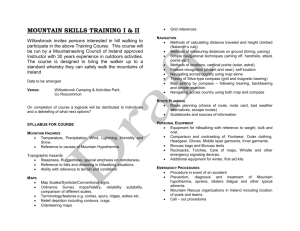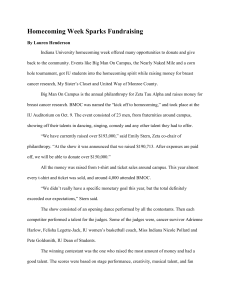Navigation Tactics
advertisement
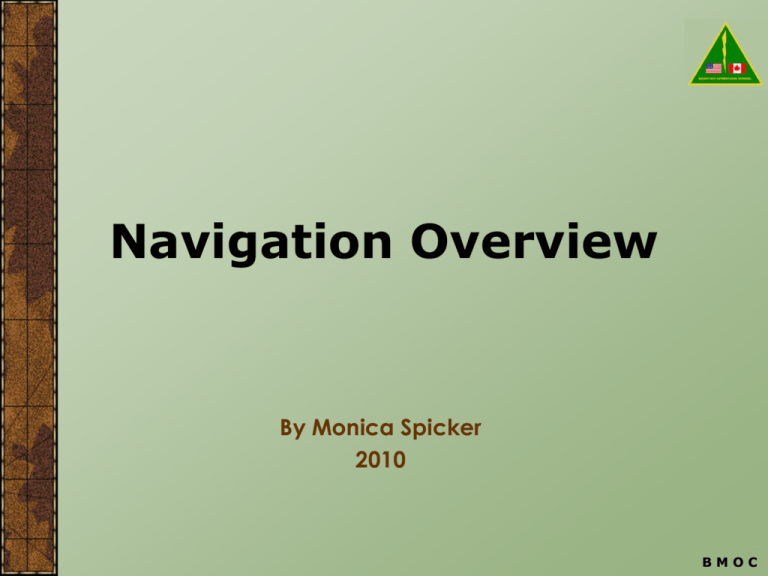
Navigation Overview By Monica Spicker 2010 BMOC Movement and Route Selection 1. Plan the route Mission Distance, Terain, Conditions Fitness and experience of personnel Careful evaluation of maps and photos Check points Linear features that cross route are best. Decision Points Places where there is a change in direction Catching features Know when you have gone too far Multiple or alternate routes Time BMOC Movement and Route Selection 2. Always Know Your Location Directional orientation Distance and direction to objective Other landmarks or features Hazards Need good map reading skills! Check with GPS: need to know how to determine and how to plot coordinates BMOC Movement and Route Selection 3. Stay on route Offsets may be necessary to get around obstacles. People tend to drift to one side or the other as well as downhill. 4. Recognize Objective Select easily recognized checkpoint close to target. Determine distance and direction to target from the checkpoint. Determine features that indicate target was missed. BMOC Example Route goes from Lost Lake to the trail. Use hilltop as intermediate goal Use ridge line for safer travel and as a handrail to the trail. Creek beyond the trail would indicate you missed. Half Way pond would indicate you veered too far SE. The steep hillside would be another clue. BMOC Offsets Used to get around obstacles. Easiest by turning 90 degree angles Turning 60 degree angles and going equal distances on both legs also works. Accurate compass work and pace needed. BMOC Navigation Techniques: Dead Reckoning Distance and direction to checkpoints determined from map and followed in the field. Map reading, scale, pacing and compass skills! Some can be determined before going out. Rest are done in the field. A series of steering marks followed in field. At night or poor visibility, this can be someone in front who is directed into the line of travel. A series of lines from checkpoint to checkpoint (route legs). Can readjust at each checkpoint to correct for pace and compass errors. Checkpoints can be stored as waypoints, so one can fine tune or find in poor visibility with GPS. Do not rely only on GPS! BMOC Navigation Techniques: Terrain Association Identify and locate selected features on map and on the ground. Orient map to terrain Slope aspect (which way it faces), shape and steepness. Elevation. Relative position of landmarks and features (creeks, roads, outcrops, peaks) Handrail: Parallel to course Creeks, ridges, elevation Identify and use roads as handrails, even if you cannot travel on them! Catching feature: perpendicular to course When to turn When you have gone too far When you are close to objective. Usually use a combination of dead reckoning and terrain association BMOC Example of Handrail & Catching Features Objective 2 Handrails: west of creek but east of ridge (can’t be seen) 5400 ft elevation: catching feature Turn west. planned travel route Use pace and compass &/or GPS waypoint to zero in on target. Creek = catching feature. (You missed the pt.) Deliberate offset: turn at elevation higher than target, so you know you would have to come downhill in all cases. BMOC Other Considerations Planning: Check and decision points Pre-identified and marked on a map. Set up a table with the coordinates of the points as well as the distance and bearing between the points Be prepared to adjust this in the field! Rally point: Place to gather if separated. Identified during planning and in field. Regularly designated during mission. Can be a checkpoint Safety direction (“Panic azimuth”) Direction that gets everyone to a known feature from anywhere. Everyone knows their position at all times! Get separated from group Navigator out of commission Do not rely on only one instrument or technique. BMOC DETERMINING DISTANCE Rule-of-Thumb Method YOUR ARM IS ten times longer than the distance between your eyes. Example, you're standing on the side of a hill, trying to decide how far it is to the top of a low hill on the other side of the valley. Just below the hilltop is a barn, about 100 feet wide on the side facing you. 1. Hold one arm straight out in front of you, elbow straight, thumb pointing up. 2. Close one eye, and align one edge of your thumb with one edge of the barn. 3. Without moving your head or arm, switch eyes, now sighting with the eye that was closed and closing the other. 4. Your thumb will appear to jump sideways as a result of the change in perspective. 5. How far did it move? (Sight the same edge of your thumb when you switch eyes). • Let's say it jumped about five times the width of the barn, or about 500 feet. • Now multiply that figure by the handy constant 10 (the ratio of the length of your arm to the distance between your eyes), and you get the distance between you and the barn -- 5,000 feet, or about one mile. 1. You estimate that the small barn is 60 feet wide. 2. You stretch your arm out, put your thumb up and close one eye. 3. You switch closed eye with open eye. 4. And find that your thumb moved the distance of two barn widths. 5. 60 x 2 x 10 = 1200 ft 60 ft 1200 ft Determining Direction w/o a Compass Shadow-stick method Wait 10 to 15 minutes between first and second marks BMOC Determining Direction w/o a Compass Watch method The split is NOONWARDS if before 6am or after 6pm. During daylight savings time, use the 1 instead of the 12! BMOC Determining Direction w/o a Compass At night BMOC Where is Polaris? BMOC Where is Polaris? BMOC Using the Mission Planning Worksheet BMOC
